avia.wikisort.org - Aeroplane
The Beechcraft Model 18 (or "Twin Beech", as it is also known) is a 6- to 11-seat,[1] twin-engined, low-wing, tailwheel light aircraft manufactured by the Beech Aircraft Corporation of Wichita, Kansas. Continuously produced from 1937 to November 1969 (over 32 years, a world record at the time), over 9,000 were built, making it one of the world's most widely used light aircraft. Sold worldwide as a civilian executive, utility, cargo aircraft, and passenger airliner on tailwheels, nosewheels, skis, or floats, it was also used as a military aircraft.[2][3][4]
| Model 18 | |
|---|---|
 | |
| A Model 18 over Little Gransden Airfield in 2019 | |
| Role | Trainer, transport aircraft and utility aircraft |
| National origin | United States |
| Manufacturer | Beech Aircraft Corporation |
| First flight | January 15, 1937 |
| Introduction | 1937 |
| Primary users | United States Army Air Forces United States Navy Royal Air Force Royal Canadian Air Force |
| Produced | 1937–1970 |
| Number built | 9,000+ |
During and after World War II, over 4,500 Beech 18s were used in military service—as light transport, light bomber (for China), aircrew trainer (for bombing, navigation, and gunnery), photo-reconnaissance, and "mother ship" for target drones—including United States Army Air Forces (USAAF) C-45 Expeditor, AT-7 Navigator, and AT-11 Kansan; and United States Navy (USN) UC-45J Navigator, SNB-1 Kansan, and others. In World War II, over 90% of USAAF bombardiers and navigators trained in these aircraft.[2][3][5]
In the early postwar era, the Beech 18 was the pre-eminent "business aircraft" and "feeder airliner". Besides carrying passengers, its civilian uses have included aerial spraying, sterile insect release, fish stocking, dry-ice cloud seeding, aerial firefighting, air-mail delivery, ambulance service, numerous movie productions, skydiving, freight, weapon- and drug-smuggling, engine testbed, skywriting, banner towing, and stunt aircraft. Many are now privately owned, around the world, with 240 in the U.S. still on the FAA Aircraft Registry in August 2017.[2][4][6][7]
Design and development
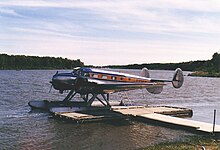
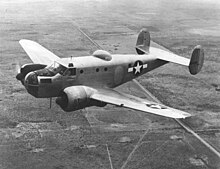

By the late 1930s, Beechcraft management speculated that a demand would exist for a new design dubbed the Model 18, which would have a military application, and increased the main production facilities. The design was mainly conventional for the time, including twin radial engines, all-metal semimonocoque construction with fabric-covered control surfaces, and tailwheel undercarriage. Less conventional was the twin-tailfin configuration. The Model 18 can be mistaken for the larger Lockheed Electra series of airliners, which closely resemble it. Early production aircraft were powered either by two 330-hp (250-kW) Jacobs L-6s or 350-hp (260-kW) Wright R-760Es. The 450-hp (336-kW) Pratt & Whitney R-985 became the definitive engine from the prewar C18S onwards. The Beech 18 prototype first flew on January 15, 1937.
The aircraft has used a variety of engines and has had a number of airframe modifications to increase gross weight and speed. At least one aircraft was modified to a 600-hp (447-kW) Pratt & Whitney R-1340 powerplant configuration. With the added weight of about 200 lb (91 kg) per engine, the concept of a Model 18 fitted with R-1340 engines was deemed unsatisfactory due to the weakest structural area of the aircraft being the engine mounts. Nearly every airframe component has been modified.
In 1955, deliveries of the Model E18S commenced; the E18S featured a fuselage that was extended 6 in (150 mm) higher for more headroom in the passenger cabin. All later Beech 18s (sometimes called Super 18s) featured this taller fuselage, and some earlier models (including one AT-11) have been modified to this larger fuselage. The Model H18, introduced in 1963, featured optional tricycle undercarriage. Unusually, the undercarriage was developed for earlier-model aircraft under an STC by Volpar, and installed in H18s at the factory during manufacture. A total of 109 H18s was built with tricycle undercarriage, and another 240 earlier-model aircraft were modified with this.[8][9]
Construction of the Beechcraft Model 18 ended in 1970 with a final Model H18 going to Japan Airlines.[citation needed] Through the years, 32 variations of the basic design had flown, over 200 improvement modification kits were developed, and almost 8,000 aircraft were built. In one case, the aircraft was modified to a triple tail, trigear, humpbacked configuration and appeared similar to a miniature Lockheed Constellation. Another distinctive conversion was carried out by Pacific Airmotive as the PacAero Tradewind. This featured a lengthened nose to accommodate the tricycle nosewheel, and the Model 18's twin tailfins were replaced by a single fin.[10]
Operational history

Production got an early boost when Nationalist China paid the company US$750,000 for six M18R light bombers,[11] but by the time of the U.S. entry into World War II, only 39 Model 18s had been sold, of which 29 were for civilian customers.[8][12] Work began in earnest on a variant specifically for training United States Army Air Forces (USAAF) military pilots, bombardiers, and navigators. The effort resulted in the Army AT-7. Further development led to the AT-11 navigation trainer, C-45 military transport, and F-2 (the "F" standing for "Fotorecon", short for "photographic reconnaissance"). The United States Navy first adopted the Beech 18 as the JRB-1, equivalent to the F-2, followed by the JRB-2 transport; the JRB was initially named the Voyager, but this name did not enter common use, and JRBs were generally called Expeditors like their USAAF counterparts.[13] The first JRB-1 obtained by the Navy, bureau number (BuNo) 09771, was converted from the last civil Model 18 built before production was earmarked solely for the military for the duration of the war.[14] The Navy subsequently obtained more Model 18s as the JRB-3 (C-45B), JRB-4 (UC-45F), SNB-1 Kansan (AT-11), SNB-2 (AT-7), and SNB-2C (AT-7C).[15] Existing naval Twin Beeches were subsequently modified into the SNB-2H air ambulance, SNB-2P reconnaissance trainer, and SNB-3Q electronic countermeasures trainer.[16] The United States Coast Guard acquired seven JRB-4 and JRB-5 aircraft from the Navy between 1943 and 1947; they were primarily used as utility transports, with one aircraft later converted for aerial mapping, and another used for proficiency flying.[17][18]
After the war, the USAAF became the United States Air Force (USAF), and the USAF Strategic Air Command had Model 18 variants (AT-11 Kansans, C-45 Expeditors, F-2 Expeditors, and UC-45 Expeditors) from 1946 until 1951. In 1950, the Navy still had around 1,200 JRB and SNB aircraft in inventory.[16] From 1951 to 1955, the USAF had many of its aircraft remanufactured with new fuselages, wing center sections, and undercarriages to take advantage of the improvements to the civil models since the end of World War II. Eventually, 900 aircraft were remanufactured to be similar to the then-current Model D18S and given new designations, constructor's numbers, and Air Force serial numbers.[19] The USN had many of its surviving aircraft remanufactured as well, resulting in the JRB-6, the SNB-5, and SNB-5P.[20] The Coast Guard retired its JRBs in 1956 and sold most of them as surplus in 1959, but one was retained by the United States Coast Guard Reserve until at least 1972.[17][18] With the adoption of the 1962 United States Tri-Service aircraft designation system, the Navy's SNB-5 and SNB-5P became the TC-45J and RC-45J respectively, later becoming the UC-45J as their primary mission shifted from aircrew training to utility transport work.[21] The C-45 flew in USAF service until 1963, the USN retired its last UC-45J in 1972, while the U.S. Army flew its C-45s until 1976. In later years, the military called these aircraft "bug smashers" in reference to their extensive use supplying mandatory flight hours for desk-bound aviators in the Pentagon.[22]
Beech 18s were used extensively by Air America during the Vietnam War; initially more-or-less standard ex-military C-45 examples were used, but then the airline had 12 aircraft modified by Conrad Conversions in 1963 and 1964 to increase performance and load-carrying capacity. The modified aircraft were known as Conrad Ten-Twos, as the maximum takeoff weight (MTOW) was increased to 10,200 lb (4,600 kg).[23][24] The increase was achieved by several airframe modifications, including increased horizontal stabilizer angle-of-incidence, redesigned undercarriage doors, and aerodynamically improved wingtips. Air America then had Volpar convert 14 aircraft to turboprop power, fitted with Garrett AiResearch TPE-331 engines; modified aircraft were called Volpar Turbo Beeches, and also had a further increase in MTOW to 10,286 lb (4,666 kg).[23]
Spar problems
The wing spar of the Model 18 was fabricated by welding an assembly of tubular steel. The configuration of the tubes in combination with drilled holes from aftermarket STC modifications on some of these aircraft have allowed the spar to become susceptible to corrosion and cracking while in service.[25] This prompted the FAA to issue an Airworthiness Directive in 1975, mandating the fitting of a spar strap to some Model 18s. This led, in turn, to the retirement of a large number of STC-modified Model 18s when owners determined the aircraft were worth less than the cost of the modifications. The corrosion on unmodified spars was not a problem; it occurred due to the additional exposed surface area created through the STC hole-drilling process. Further requirements have been mandated by the FAA and other national airworthiness authorities, including regular removal of the spar strap to allow the strap to be checked for cracks and corrosion and the spar to be X-rayed. In Australia, the airworthiness authority has placed a life limit on the airframe, beyond which aircraft are not allowed to fly.[26][27][28]
Variants
Manufacturer models
Unless otherwise noted, the engines fitted are Pratt & Whitney R-985 radials.
- Model 18A
- First production model with seating for two pilots and seven or eight passengers, fitted with Wright R-760E-2 engines of 350 horsepower (260 kW), MTOW: 6,700 lb (3,000 kg)[29][30] Four built.[31]
- Model S18A
- Version of Model 18A capable of being fitted with skis or Edo 55-7170 floats; MTOW: 7,200 lb (3,300 kg)[30]
- Model A18A
- Version fitted with Wright R-760E-2 engines, MTOW: 7,500 lb (3,400 kg)[32]
- Model SA18A
- Seaplane version of Model A18A, MTOW: 7,170 lb (3,250 kg)[32]
- Model 18B
- Version powered with 285 hp (213 kW) Jacobs L-5 engines. Four built.[33][31]
- Model S18B
- Version of Model 18B capable of being fitted with skis or floats.
- Model 18D
- Variant with seating for two pilots and nine passengers, fitted with Jacobs L-6 engines of 330 horsepower (250 kW), MTOW: 7,200 lb (3,300 kg).[32] Twelve aircraft built.[31]
- Model S18D
- Version of Model 18D capable of being fitted with skis or Edo 55-7170 floats[citation needed], MTOW: 7,170 lb (3,250 kg)[12][failed verification][32]
- Model A18D
- Variant of 18D with MTOW increased by 300 lb (140 kg) to 7,500 lb (3,400 kg).[32]
- Model SA18D
- Seaplane version of Model A18D, but same MTOW as S18D.[32]
- Model 18R
- Model with Pratt and Whitney R-985-A1 engines with dual-stage blower for increased power at higher operating altitudes[citation needed], 420 horsepower (310 kW), seven built, one to Sweden as an air ambulance, six to Nationalist China as M18R light bombers[11][31]
- Model 18S
- Nine-passenger pre-World War II civil variant, powered by 450 hp (340 kW) served as basis for USAAF C-45C[1]
- Model B18S
- Nine-passenger pre-World War II civil variant, served as basis for USAAF F-2[1]
- Model C18S
- Variant of B18S with seating for eight passengers, and equipment and minor structural changes[34]
- Model D18S
- First post-World War II variant introduced in 1945, with seating for eight passengers and MTOW of 8,750 lb (3,970 kg), 1,035 built[35][36]
- Model D18C
- Variant with Continental R9-A engines of 525 horsepower (391 kW) and MTOW of 9,000 lb (4,100 kg), introduced in 1947, 31 built.[35][37]
- Model E18S
- Variant with redesigned wing and MTOW of 9,300 lb (4,200 kg); 403 built[35]
- Model E18S-9700
- Variant of E18S with MTOW of 9,700 lb (4,400 kg); 57 built[35]
- Model G18S
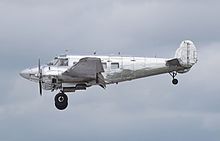
- Model H18
- Last production version, fitted with optional tricycle undercarriage developed by Volpar and MTOW of 9,900 lb (4,500 kg); 149 built, of which 109 were manufactured with tricycle undercarriage[8][35][36]
Military versions
USAAC/USAAF designations
- RC-45A
- Redesignation of all surviving F-2, F-2A, and F-2B aircraft by the USAF in 1948
- C-45B
- Based on C18S, but with modified internal layout; 223 ordered, redesignated UC-45B in 1943[34][39]
- C-45C
- Two Model 18S aircraft impressed into the USAAF, redesignated UC-45C in January 1943[1][29][40]
- C-45D
- Designation given to two AT-7 aircraft converted as passenger transports during manufacture, redesignated UC-45D in January 1943[40][41]
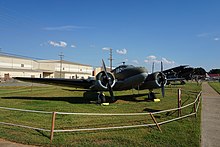

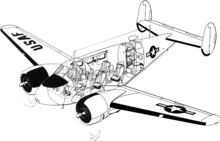
- C-45E
- Designation given to two AT-7 and four AT-7B aircraft converted as passenger transports during manufacture, redesignated UC-45E in January 1943[40][41]
- C-45F
- Standardized seven-seat version based on C18S, with longer nose than preceding models;[34] 1,137 ordered, redesignated UC-45F[39]
- C-45G
- AT-7s and AT-11s remanufactured in the early 1950s for the USAF to similar standard as civil D18S with autopilot and R-985-AN-3 engines; 372 aircraft rebuilt[19][42]
- TC-45G
- Multiengine crew trainer variant of C-45G; AT-7s and AT-11s remanufactured in the early 1950s for the USAF to similar standard as civil D18S, 96 aircraft rebuilt[19][42]
- C-45H
- AT-7s and AT-11s remanufactured in the early 1950s for the USAF to similar standard as civil D18S, with no autopilot and R-985-AN-14B engines; 432 aircraft rebuilt[19][43]
- TC-45H [35]

- AT-7 Navigator
- Navigation trainer based on C18S,[34] with an astrodome and positions for three students, powered by 450-hp Pratt & Whitney R-985-25 engines; 577 built[38][39]
- AT-7A
- Floatplane version of AT-7; six built[38]
- AT-7B
- Winterised AT-7; nine built[38]
- AT-11 Kansan
- Bombing and gunnery trainer for USAAF derived from AT-7, fuselage had small, circular cabin windows, bombardier position in nose, and bomb bay; gunnery trainers were also fitted with two or three .30-caliber machine guns, early models (the first 150 built) had a single .30-cal AN-M2 in a Beechcraft-manufactured top turret, later models used a Crocker Wheeler twin .30-cal top turret, a bottom tunnel gun was used for tail gunner training, 1,582 built for USAAF orders, with 24 ordered by Netherlands repossessed by USAAF and used by the Royal Netherlands Military Flying School at Jackson, Mississippi.[44][45]
- AT-11A
- Conversion of AT-11 as navigation trainer; 36 converted[45]
- CQ-3
- Conversion of UC-45F, modified to act as drone control aircraft, redesignated as DC-45F in June 1948[citation needed]
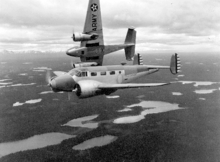
- F-2
- Photo-reconnaissance version based on B18[1]
- F-2A
- Improved version
- F-2B
US Navy designations
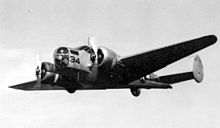
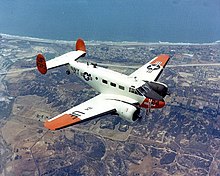
- JRB-1
- Photographic aircraft, based on the C18S,[34] fitted with fairing over cockpit for improved visibility, 11 obtained, at least one conversion from impressed civil B18S[14]
- JRB-2
- Light transport, based on the C18S;[34] 15 obtained, at least one conversion from JRB-1,[47] some transferred from USAAF C-45A stocks[48]
- JRB-3
- Photographic version, similar to C-45B; 23 obtained, some transferred from USAAF C-45B stocks[49]
- JRB-6
- Remanufactured JRB[21]
- SNB-2H
- Ambulance conversion[16]
- SNB-2P
- Photo-reconnaissance trainer conversion[16]
- SNB-3Q
- Electronic countermeasures trainer conversion[16]
RAF/RCAF Lend-lease designations
- Expeditor I
- C-45Bs supplied to the RAF under Lend-Lease
- Expeditor II
- C-45Fs supplied to the RAF and Royal Navy under Lend-Lease
- Expeditor III
- C-45Fs supplied to the RCAF under Lend-Lease
Post-war RCAF designations
C-45Ds delivered between 1951 and 1952[54]
- Expeditor 3N
- navigation trainer - 88 built[55]
- Expeditor 3NM
- navigational trainer that could be converted to a transport - 59 built[56]
- Expeditor 3NMT
- 3NM converted to a transport aircraft - 67 built[57]
- Expeditor 3NMT(Special)
- navigation trainer/personnel transport - 19 built[58]
- Expeditor 3TM
- transport with fittings so it could be converted to a navigation trainer - 44 built[55]
- Expeditor 3TM(Special)
- modified RCAF Expeditors used overseas in conjunction with Project WPB6 - three built[59]
Canadian Armed Forces
- CT-128 Expeditor
- 1968 redesignation of existing RCAF aircraft upon unification of the Canadian Armed Forces
Conversions
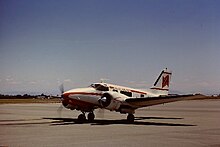
- Conrad 9800
- Modification increasing the gross weight to 9,800 pounds with a single piece windshield [60]
- Dumod I
- Executive conversion with Volpar tricycle landing gear, new wing tips, enlarged fight deck and refurbished 6–7 seat cabin with larger windows. Originally named Infinité I. 37 converted by 1966.[61]
- Dumod Liner
- Stretched airliner conversion. Similar to Dumod I but with forward fuselage stretched by 6 feet 3 inches (1.91 m), allowing up to 15 passengers to be carried. Originally named Infinité II.[61]
- Hamilton HA-1
- conversion of a TC-45J aircraft
- Hamilton Little Liner
- Modification of D18S with aerodynamic improvements and new, retractable tailwheel, capable of carrying 11 seats[62]
- Hamilton Westwind
- Turboprop conversions with various engines

- Hamilton Westwind II STD
- Stretched conversion powered by two 840-hp PT6As, and with accommodation for up to 17 passengers[63]
- Hamilton Westwind III
- two 579-hp PT6A-20s or 630-hp PT6A-27s or 630-hp Lycoming LTS101s.
- Hamilton Westwind IV
- two 570-hp Lycoming LTP101s or 680-hp PT6A-28s or 750-hp PT6A-34s or 1020-hp PT6A-45s
- PacAero Tradewind
- Conversion of Beech D18S/C-45 to five- to 11-seat executive transport with single fin by Pacific Airmotive
- Rausch Star 250
- Built as C-45F 44-47231, this aircraft was re-manufactured at Wichita by Beech in 1952, to become TC-45G 51-11544. From 1959 Rausch Engineering Inc. of South San Francisco, California, converted N8186H to tricycle undercarriage, using forward retracting main gear from a P-51 and rearward-retracting nose-leg from a T-28, adding a 3 ft (0.91 m) nose extension, 4 ft (1.22 m) rear fuselage extension, re-roofed fuselage for increased headroom and enlarged cabin windows. The modifications did not obtain FAA certification despite 58 hours of flight testing, with the aircraft eventually being broken up at Antioch, CA, in 1978.[64]
- SFERMA-Beechcraft PD.18S
- Modification of Beech 18S powered by two Turboméca Bastan turboprops[65]
- Volpar (Beechcraft) Model 18
- Conversion of Model 18 with nosewheel undercarriage[66][67]
- Volpar (Beechcraft) Super 18
- Volpar (Beechcraft) Turbo 18
- Beech Model 18s fitted with the Volpar MkIV tricycle undercarriage and powered by two 705-hp Garrett TPE331-1-101B turboprop engines, flat-rated to 605 hp (451 kW), driving Hartzell HC-B3TN-5 three-bladed, reversible-pitch, constant-speed feathering propellers[67]
- Volpar (Beechcraft) Super Turbo 18
- 2x 705 hp (526 kW) Garrett TPE331
- Volpar (Beechcraft) C-45G
- C-45G aircraft modified with tricycle undercarriage
- Volpar (Beechcraft) Turboliner
- 15-passenger version of the Turbo 18 with extended fuselage, powered by 2 705-hp Garrett TPE331-1-101Bs[68]
- Volpar (Beechcraft) Turboliner II
- Turboliners modified to meet SFAR 23[68]
Operators
Civil
As of 2012[update], the Beechcraft Model 18 remains popular with air charter companies and small feeder airlines worldwide.
Military






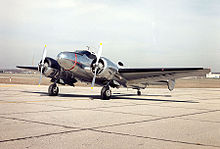
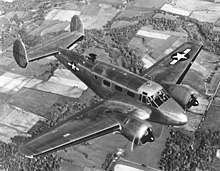

 Argentina
Argentina
 Bolivia
Bolivia
- Bolivian Air Force[71]
 Brazil
Brazil
- Brazilian Air Force[71]
 Canada
Canada
- Royal Canadian Air Force 394 examples from 1941 to 1972[72]
- Royal Canadian Navy 10 examples from 1952 to 1960[73]
- VX-10 Squadron[citation needed]
- VU-32 Squadron[74]
- Canadian Armed Forces
 Chile
Chile
- Chilean Air Force[75]
- Chilean Army
- Chilean Navy
 Colombia
Colombia
- Colombian Air Force[76]
 Costa Rica
Costa Rica
- Public Force of Costa Rica[77]
 Côte d'Ivoire[78]
Côte d'Ivoire[78] Cuba
Cuba
- Cuban Air Force - received two AT-7s, two AT-11s, a F-2B and a UC-45F in 1947[79]
 Dominican Republic
Dominican Republic
- Dominican Air Force[80]
 Ecuador
Ecuador
- Ecuadorian Air Force[77]
 El Salvador
El Salvador
- Air Force of El Salvador[81]
 France
France
 Guatemala
Guatemala
- Guatemalan Air Force[82]
 Haiti
Haiti
- Haiti Air Corps[82]
 Honduras
Honduras
- Honduran Air Force[83]
 Indonesia
Indonesia
 Iran
Iran Italy
Italy
- Italian Air Force operated 125 aircraft from 1949 until the 1970s[84]
 Japan
Japan
- Japan Maritime Self-Defense Force
- Japan Coast Guard
 Mexico
Mexico
 Netherlands
Netherlands
 Nicaragua
Nicaragua
- Nicaraguan Air Force[78]
 Niger
Niger
- Niger Air Force[78]
 Nigeria
Nigeria Paraguay
Paraguay
- Paraguayan Air Force[86]
 Peru
Peru
- Peruvian Air Force[86]
 Philippines
Philippines
- Philippine Army Air Corps[78]
 Portugal
Portugal
 Somalia
Somalia
- Somali Air Force[87] – Withdrawn in 1991
 South Africa
South Africa
- South African Air Force
 South Vietnam
South Vietnam
- Republic of Vietnam Air Force[88]
 Spain
Spain Sri Lanka
Sri Lanka
- Sri Lanka Air Force[87]
 Sweden
Sweden
- Swedish Air Force[89]
 Switzerland
Switzerland
 Taiwan
Taiwan
- Republic of China Air Force[90]
 Thailand
Thailand
- Royal Thai Air Force[91]
 Tonga
Tonga
- Tongan Maritime Force Air Force
 Turkey
Turkey
- Turkish Air Force[91]
 United Kingdom
United Kingdom
 United States
United States
- United States Army
- United States Army Air Corps
- United States Army Air Forces
- United States Air Force
- United States Coast Guard[17][18]
- United States Coast Guard Reserve[18]
- United States Marine Corps
- United States Navy
 Uruguay
Uruguay
- Uruguayan Air Force[92]
 Venezuela
Venezuela
- Venezuelan Air Force[93]
 Zaire
Zaire
- Zairian Air Force[93]
Accidents and incidents
The Beechcraft Model 18 family has been involved in the following notable accidents and incidents:
- April 25, 1951: Cubana de Aviación Flight 493, a Douglas DC-4 bound from Miami to Havana, registration CU-T188, collided with a U.S. Navy SNB-1, bureau number 39939, on a practice instrument approach to Naval Air Station Key West. The collision and ensuing crashes killed all 34 passengers and five crew aboard the DC-4 and all five crew aboard the SNB. The accident occurred at midday, weather was clear with unlimited visibility, and both flight crews had been cleared to fly under visual flight rules, being expected to "see and avoid" other aircraft; the student flying the SNB was wearing view-limiting goggles, but the other SNB crew were not, and were expected to keep watch. Ground witnesses said that neither aircraft took evasive action prior to the collision, and the Civil Aeronautics Board attributed the accident to the failure of both flight crews to see and avoid conflicting air traffic.[94]
- 1967: Mohammed bin Awad bin Laden was killed in the crash of a Beechcraft 18 in Saudi Arabia.[95]
- December 10, 1967: American soul music singer Otis Redding, four members of his backing band the Bar-Kays, the pilot, and another member of Redding's entourage were killed in the crash of Redding's H18, registration N390R, into Lake Monona on approach to Truax Field in Wisconsin. The National Transportation Safety Board (NTSB) was unable to determine the cause of the crash, noting that the left engine and propeller were not recovered.[96][97] Trumpet player Ben Cauley, the sole survivor, subsequently revived the Bar-Kays together with another band member who was aboard a different aircraft.[98]
- September 20, 1973: American folk music singer-songwriter Jim Croce, four members of his entourage, and the pilot were killed when their chartered E18S, registration N50JR, crashed into a tree on takeoff from Natchitoches Regional Airport in Louisiana.[99][100][101] The NTSB attributed the accident to reduced visibility due to fog, and to physical impairment of the pilot, who had severe coronary artery disease and had run 3 mi (4.8 km) to the airport.[101] An investigation conducted for a lawsuit against the charter company attributed the accident solely to pilot error, citing his downwind takeoff into a "black hole" of severe darkness, causing him to experience spatial disorientation.[102]
- September 26, 1978: Air Caribbean Flight 309, an air taxi flight by a D18S, registration N500L, crashed on approach to Isla Verde International Airport in Puerto Rico, killing the pilot and the five passengers aboard the aircraft and causing substantial property damage and injuries to bystanders on the ground. The pilot could not communicate with approach control and was following directions relayed by local tower controllers, who told the pilot to make a turn and maintain separation from a Lockheed L-1011 that was overtaking the flight, but the pilot did not turn, and the D18S passed underneath and very close to the L-1011. Both the NTSB and a U.S. District Court ruling attributed the crash to the D18S pilot's failure to correctly follow visual flight rules and air traffic control instructions to maintain separation from the much larger L-1011, causing a loss of aircraft control due to wake turbulence.[103][104] A contributing factor was the pilot's difficulties in communication with controllers.[103]
Aircraft on display
Argentina
- AT-11A 3495 – at the Museo Nacional de Aeronáutica de Argentina in Buenos Aires.[105]
- C-45H 5621 – at the Museo Nacional de Aeronáutica de Argentina in Buenos Aires.[106]
- C-45H AF-555 – at the Museo Nacional de Aeronáutica de Argentina in Buenos Aires.[107]
- H18S c/no. BA-752 (former LV-JFH) – at the Museo Nacional de Aeronáutica de Argentina in Buenos Aires.[108]
Australia
- E18S c/no. BA-81 (former N3781B) - at the Queensland Air Museum in Caloundra, Queensland.[109]
Belgium
- 3NM floatplane c/no CA-191 (former C-FGNR) – at Pairi Daiza.[110][better source needed]
Brazil
- AT-11 4615 - at the Museu Aeroespacial in Rio de Janeiro, Brazil.[111][112]
- C-45F 2856 - at the Museu Aeroespacial in Rio de Janeiro, Brazil.[113][114]
Canada
- C-45H 459 – at the Canadian Bushplane Heritage Centre in Sault Ste. Marie, Ontario. Tail code CF-MJY[115][116]
- 3TM 8034 – at the Canadian Bushplane Heritage Centre in Sault Ste. Marie, Ontario.[117]
- D18S c/no. A-141 (former CF-MPH) – at the RCMP Academy, Depot Division in Regina, Saskatchewan.[118]
- D18S c/no. A-142 (former CF-MPI) – at the Bomber Command Museum of Canada in Nanton, Alberta.[118][119]
- D18S c/no. A-156 – at the Canadian Warplane Heritage Museum in Hamilton, Ontario.[120]
- 3N c/no. A-652 (former RCAF 1477) – at the Royal Aviation Museum of Western Canada in Winnipeg, Manitoba.[118][121]
- 3NMT c/no. A-700 – at the Canadian Air Land Sea Museum at Toronto/Markham Airport in Markham, Ontario.[118]
- 3NM c/no. A-710 – at the North Atlantic Aviation Museum in Gander, Newfoundland and Labrador.[118][122]
- 3NMT c/no. A-782 (former CF-CKT) – at the Canadian Museum of Flight in Langley, British Columbia.[123][124]
- 3NMT c/no. A-872 – at the TransCanada Highway in Ignace, Ontario.[118][125]
- 3NM c/no. A-895 – at the Alberta Aviation Museum in Edmonton, Alberta.[118][126]
Chile
- D18S c/no. A-1024 (former FACh 465) – at the Museo Aeronautico y del Espacio in Santiago, Chile.[127][128]
India
- D18S VT-CNY former aircraft of the Raja of Mayurbhanj and later sold to Coal India Limited- at the Hotel Mayfair Lagoon in Bhubaneswar, Orissa.[129]
Italy
- C-45F 6668 – suspended inside the Olbia Costa Smeralda Airport passenger terminal in Olbia, Sardinia.[130] This was the first aircraft owned by Alisarda Airlines and was used in the filming of the movie The Last Emperor.[131]
Malta
Mexico
- UC-45J Expeditor "ETL-1320" (S/N): 18 - at the Museo Militar de Aviación.[citation needed]
Netherlands
New Zealand
- AT-11 3691 - at the Museum of Transport and Technology in Auckland, New Zealand.[135][better source needed]
Portugal
- AT-11 2504 - at the Museu do Ar in Sintra, Portugal.[130]
Spain
- C-45H AF-752– at Fundación Infante de Orleans in Madrid, Spain.[136]
Turkey
- AT-11 Kansan 6390/9-930 – at Istanbul Aviation Museum.[137]
United Kingdom
- E18S G-ASUG c/no. BA-111 – at the National Museum of Flight in East Lothian, Scotland.[138][139]
United States
- AT-11 41‐27561 – at the National Museum of the USAF in Dayton, Ohio.[140][141] or 42-37493[130]
- AT-11B 41-27616 – at the Travis Air Force Base Heritage Center at Travis AFB, California.[130][142]
- AT-11 42-36887 – at the Barksdale Global Power Museum in Bossier City, Louisiana.[143]
- AT-11 42-37240 – at the Lone Star Flight Museum in Galveston, Texas.[144][145]
- UC-45 42-37496 – at the Wings Over the Rockies Air and Space Museum in Denver, Colorado. This aircraft was originally an AT-11 before being remanufactured.[146]
- UC-45F 44-47342 – at the Alaska Aviation Heritage Museum in Anchorage, Alaska.[147][148]
- C-45G 51-11467 – at the EAA Chapter 1241 Air Museum at the Florida Keys Marathon Airport in Marathon, Florida.[149]
- TC-45H 51-11529 – at the Tri-State Warbird Museum in Batavia, Ohio.[150]
- C-45H 51-11696 – at the Museum of Flight in Seattle, Washington.[151]
- C-45G 51-11795 – at the Air Mobility Command Museum in Dover, Delaware.[152]
- C-45G 51-11897 – at the Castle Air Museum in Atwater, California.[153][154]
- C-45H 52-10539 – at the 1941 Historical Aircraft Group Museum in Geneseo, New York.[155][156]
- C-45H 52-10865 – at the Travis Air Force Base Heritage Center at Travis AFB, California.[157][158]
- C-45H 52-10893 – at the National Museum of the USAF in Dayton, Ohio.[159]
- UC-45J 09771 – at the National Museum of Naval Aviation in Pensacola, Florida. This aircraft was converted from the last civil Beech 18 built prior to WWII.[14]
- UC-45J 23774 – at Laughlin AFB in Del Rio, Texas.[130]
- RC-45J 51233 – at the Tennessee Museum of Aviation in Sevierville, Tennessee.[160][161]
- UC-45J 51242 – at the CAF Central Texas Wing in San Marcos, Texas.[162]
- UC-45J 51291 – at the Aerospace Museum of California in Sacramento, California.[163]
- UC-45J 51338 – at the Minnesota Air National Guard Museum in St. Paul, Minnesota.[164]
- S18D c/no. 178 – at the Beechcraft Heritage Museum in Tullahoma, Tennessee.[165]
- D18S c/no. A-935 – at the Beechcraft Heritage Museum at Tullahoma Regional Airport in Tullahoma, Tennessee.[165]
- C-45H AF-824 – at the Beechcraft Heritage Museum in Tullahoma, Tennessee.[165]
- E18S c/no. BA-453 – at the Beechcraft Heritage Museum in Tullahoma, Tennessee.[165]
- H18 c/no. BA-670 – at the Lone Star Flight Museum in Galveston, Texas.[166]
Specifications (UC-45 Expeditor)

Data from Jane's Fighting Aircraft of World War II.[167]
General characteristics
- Crew: 2 pilots
- Capacity: 6 passengers
- Length: 34 ft 3 in (10.44 m)
- Wingspan: 47 ft 8 in (14.53 m)
- Height: 9 ft 9 in (2.97 m)
- Wing area: 349 sq ft (32.4 m2)
- Empty weight: 5,420 lb (2,458 kg)
- Gross weight: 7,500 lb (3,402 kg)
- Powerplant: 2 × Pratt & Whitney R-985-AN-1 "Wasp Junior" radial engines, 450 hp (340 kW) each
Performance
- Maximum speed: 225 mph (362 km/h, 196 kn)
- Range: 1,200 mi (1,900 km, 1,000 nmi) at 160 mph (260 km/h; 140 kn) and 5,000 ft (1,500 m)
- Service ceiling: 26,000 ft (7,900 m)
- Rate of climb: 1,850 ft/min (9.4 m/s)
See also
Aircraft of comparable role, configuration, and era
- Airspeed Oxford
- Avro Anson
- Barkley-Grow T8P-1
- Cessna AT-17 Bobcat
- De Havilland Dove
- Evangel 4500
- Fairchild AT-21 Gunner
- Lockheed Model 10 Electra
- Lockheed Model 12 Electra Junior
- Siebel Si 204
Related lists
- List of aircraft of World War II
- List of military aircraft of the United States
References
Notes
- "Type Certification Data Sheet No. 710: 18S, B18S, Rev 3" (PDF). Federal Aviation Administration. October 12, 2016. Retrieved September 9, 2022.
- "Beechcraft D18S Twin Beech." Archived June 30, 2016, at the Wayback Machine National Air and Space Museum of the Smithsonian Institution, Washington, D.C. Retrieved: December 17, 2014.
- "Fact Sheet: Beech C-45H Expeditor." National Museum of the U.S. Air Force, Wright-Patterson Air Force Base, Dayton, Ohio. Retrieved: August 5, 2017.
- "Twin Beech: The 1930s airplane that set Beech Aircraft Corporation on a course towards 50 years of success" Flying Magazine, February 1982, pp. 26-30, Retrieved: August 5, 2017
- "Fact Sheet: Beech AT-11 Kansan." National Museum of the U.S. Air Force, Wright-Patterson Air Force Base, Dayton, Ohio. Retrieved: August 5, 2017.
- Bauschspies, James S. and William E. Simpson, "Research and Technology Program Perspectives for General Aviation and Commuter Aircraft", NASA Contract NASW-3554 for NASA, Sept. 1982, N83-17454#. Retrieved: Dec. 18, 2014. (In particular, see: Table 2.4 "COMMUTER CARGO FLEET IN 1981 - TOP TEN AIRCRAFT MODELS - NUMBER IN FLEET," which notes Beech 18 units are more than the next two aircraft combined (Convair 500/680 and Douglas DC-3), and more than the next three general aviation aircraft combined.
- "Beech 18" FAA Aircraft Registry. Federal Aviation Administration. Retrieved: August 5, 2017.
- "Model 18 Specifications." Beechcraft Heritage Museum. Retrieved: August 24, 2008.
- "Some of the Differences Between the Models and Modifications of the Beech 18". twinbeech.com. September 30, 2006. Retrieved August 5, 2017.
- "Beechcraft 3NMT Expeditor." Canadian Museum of Flight. Retrieved: August 13, 2012.
- "Beechcraft page." Aerofiles. Retrieved: August 12, 2008.
- "S18D." Beechcraft Heritage Museum. Retrieved: August 12, 2008.
- Swanborough & Bowers 1976, p. 41.
- Baugher, Joe (August 16, 2022). "US Navy and US Marine Corps BuNos, Third Series (00001 to 10316)". joebaugher.com. Retrieved August 23, 2022.
- Swanborough & Bowers 1976, pp. 41–42.
- Swanborough & Bowers 1976, p. 42.
- "Beech JRB-4/5 "Expeditor"". www.history.uscg.mil. United States Coast Guard. Retrieved August 23, 2022.
- Baugher, Joe (June 25, 2022). "US Coast Guard Aircraft Serials". joebaugher.com. Retrieved August 23, 2022.
- "C-45H." Beechcraft Heritage Museum. Retrieved: August 24, 2008.
- Swanborough & Bowers 1976, pp. 42–43.
- Swanborough & Bowers 1976, p. 43.
- O'Rourke, G.G, CAPT USN. "Of Hosenoses, Stoofs, and Lefthanded Spads." United States Naval Institute Proceedings, July 1968.
- "Air America: Beech/Volpar Turbo Beech 18". University of Texas at Dallas, 2006. Retrieved: August 5, 2017.
- Deakin, John. "Pelican's Perch #75:Those Dreadful POHs (Part 1)". AVweb, November 9, 2003. Retrieved: August 12, 2008.
- Ramey, Taigh. "Spar concerns." Twinbeech.com. Retrieved: December 17, 2014.
- Ramey, Taigh. "Vintage Aircraft: Things to Consider when Buying a Twin Beech Project." Twinbeech.com, Stockton, California. Retrieved: August 24, 2008.
- "FAA Airworthiness Directive No. AD 75-27-09." Federal Aviation Administration. Retrieved: August 24, 2008
- "CASA Airworthiness Directive No. AD/BEECH 18/17." Archived 2008-08-01 at the Wayback Machine CASA. Retrieved: August 24, 2008.
- "USA Warplanes C-45 page." Archived 2017-05-12 at the Wayback Machine uswarplanes.net. Retrieved 24 August 2008.
- "Aircraft Specification No. 630: Models Beechcraft 18A, S18A: Rev 3" (PDF). Federal Aviation Administration. October 12, 2016. Retrieved September 8, 2022.
- Pelletier 1995, p. 68
- "Aircraft Specification No. A-684: Hawker Beechcraft: 18D S18D, A18A, SA18A, A18D, SA18D : Rev3" (PDF). Federal Aviation Administration. March 26, 2007. Retrieved August 8, 2008.
- McKillop, Jack. "Beech JRB Expedition (sic), Beech SNB Kansan and Navigator". microworks.ne. Retrieved: August 28, 2008.
- "Beech C18S Type Certificate." Federal Aviation Administration. Retrieved: August 12, 2008.
- FAA Beech D18/E18/G18/H18 Series Type Certificate.. Retrieved 8 August 2008.
- "Aircraft Serial Number Lists 1945–2008." Archived 2009-04-11 at the Wayback Machine Hawker Beechcraft. Retrieved: August 8, 2008.
- "Beech 18". Airliners.net. Retrieved: August 8, 2008.
- Donald 1995, p. 7.
- Swanborough and Bowers 1963, p. 36.
- Baugher, Joe. "USAAF 1942 Serial Number List."[permanent dead link] USAAS-USAAC-USAAF-USAF Aircraft Serial Numbers–1908 to Present. Retrieved: June 11, 2011.
- Baugher, Joe. "USAAF 1943 Serial Number List."[permanent dead link] USAAS-USAAC-USAAF-USAF Aircraft Serial Numbers–1908 to Present. Retrieved: June 11, 2011.
- Baugher, Joe. "USAF 1951 Serial Number List."[permanent dead link] USAAS-USAAC-USAAF-USAF Aircraft Serial Numbers–1908 to Present. Retrieved 11 June 2011.
- Baugher, Joe. "USAF 1952 Serial Number List."[permanent dead link] USAAS-USAAC-USAAF-USAF Aircraft Serial Numbers–1908 to Present. Retrieved: August 24, 2008.
- Donald 1995, pp. 7–8.
- Swanborough and Bowers 1963, p. 37.
- Baugher, Joe (June 12, 2022). "US Navy and US Marine Corps BuNos, Third Series (80259 to 90019)". joebaugher.com. Retrieved August 23, 2022.
- Baugher, Joe (June 30, 2022). "US Navy and US Marine Corps BuNos, Third Series (90020 to 99860)". joebaugher.com. Retrieved August 23, 2022.
- Baugher, Joe (June 30, 2022). "US Navy and US Marine Corps BuNos, Third Series (70188 to 80258)". joebaugher.com. Retrieved August 23, 2022.
- Baugher, Joe (August 18, 2022). "US Navy and US Marine Corps BuNos, Third Series (39999 to 50359)". joebaugher.com. Retrieved August 23, 2022.
- Baugher, Joe (August 19, 2022). "US Navy and US Marine Corps BuNos, Third Series (60010 to 70187)". joebaugher.com. Retrieved August 23, 2022.
- Swanborough & Bowers 1976, p. 44.
- Baugher, Joe (August 18, 2022). "US Navy and US Marine Corps BuNos, Third Series (50360 to 60009)". joebaugher.com. Retrieved August 23, 2022.
- "RCAF Data Record Cards 1426 CA-1 to 1594 CA-280"". RCAF.
- "FAA Type Certificate A-765 (Beech D18/E18/G18/H18 Series)." Federal Aviation Administration, p. 48.
- For the particular breakdown of each model for the RCAF, Refer to RCAF Data Record Cards CA-1 to CA-280.
- "EO 05-45B-6A/130." RCAF, March 10, 1959.
- "EO 05-45B-2 Description and Maintenance Instructions Expeditor 3." RCAF, September 12, 1967, p. I-1.
- "EO 05-45B-1 Aircraft Operating Instructions." RCAF, September 26, 1966, Supplement B, p. 2.
- Sweeney, Richard (December 1960). "Conrad 9800". Flying. pp. 48, 49, 102.
- Taylor 1967, p. 250.
- Taylor 1965, p. 280.
- Taylor 1976, p. 300.
- "American airplanes: ra - ri". Aerofiles.com. January 18, 2009. Retrieved March 16, 2011.
- Taylor 1982, p. 67.
- Taylor 1965, p. 316.
- Taylor 1982, p. 483.
- Taylor 1982, p. 484.
- Bridgman 1951, p. 3a.
- "AVIONES DE TRANSPORTE DE LA AVIACION NAVAL - "BEECHCRAFT AT11"". Histarmar - Historia y Arqueologia Marítima (in Spanish). Fundación Histarmar. Retrieved May 2, 2015.
- Bridgman 1951, p. 4a.
- Griffin 1969, pp. 5–6.
- Pettipas 1986, pp. 42–43.
- "Utility Squadron VU 32". AEROWAREdesigns. 2012. Archived from the original on August 6, 2012. Retrieved May 12, 2022.
- Bridgman 1951, p. 6a.
- Pelletier 1995, pp. 81–82.
- Pelletier 1995, p. 82.
- Pelletier 1995, p. 83.
- Hagedorn 1993, p. 16
- Bridgman 1951, p. 7a.
- Bridgman 1951, p. 17a.
- Bridgman 1951, p. 11a.
- Bridgman 1951, p. 12a.
- "Italian Air Force." aeroflight. Retrieved: December 17, 2014.
- Bridgman 1951, p. 14a.
- Bridgman 1951, p. 16a.
- Pelletier 1995, p. 84.
- Mesko 1981, p. 1.
- Bridgman 1951, p. 19a.
- Pelletier 1995, p. 81.
- Bridgman 1951, p. 20a.
- Pelletier 1995, pp. 84–85.
- Pelletier 1995, p. 85.
- Investigation of Aircraft Accident: COMPANIA CUBANA DE AVIACION AND U.S. NAVY: KEY WEST, FLORIDA: 1951-04-25 (Report). Civil Aeronautics Board. October 22, 1951. F-104-51. Retrieved January 18, 2022.
- Doward, Jamie (August 2, 2015). "Bin Laden plane crash: aircraft went down in near perfect conditions". The Guardian. Retrieved October 20, 2022.
- NTSB Identification: CHI68A0053 (Report). National Transportation Safety Board. Retrieved January 17, 2022.
- "Singer Is Feared Dead In Air Crash". The New York Times. New York City. United Press International. December 11, 1967.
- "Ben Cauley, Sole Survivor of Otis Redding Plane Crash, Dies at 67". The New York Times. New York City. Associated Press. September 15, 2015.
- "Recording star, 5 others killed in crash of plane". Spokesman-Review. (Spokane, Washington). Associated Press. September 22, 1973. p. 9.
- "Rock group killed". The Michigan Daily. (Ann Arbor). Associated Press. September 22, 1973. p. 2.
- NTSB Identification: FTW74AF017; 14 CFR Part 135 Nonscheduled operation of Robert Airways; Aircraft: Beech E18S, registration: N50JR (Report). National Transportation Safety Board. Retrieved January 17, 2022.
- Croce v. Bromley Corporation, 623 F.2d 1084 (5th Cir. 1980) ("The plaintiffs' expert medical witness testified at length that spatial disorientation resulting from the pilot's taking off into a "black hole" was the cause of the crash. See n.12, supra. This theory was buttressed by the testimony of Asher Vandenberg, a commercial, multiengine pilot with instrument ratings.").
- NTSB Identification: DCA78AA024 (Report). National Transportation Safety Board. Retrieved January 17, 2022.
- In Re N-500L Cases, 517 F. Supp. 825 (D.P.R. 1981) ("The Court finds that the pilot of N-500L was responsible, in the VFR flight conditions which existed on the night of the accident, to visualize and to avoid wake turbulence of EAL 75. By continuing into the flight path of EAL 75 the pilot of N-500L was negligent and this negligence was a proximate cause of the crash.").
- "Airframe Dossier - Beech AT-11A Kansan, s/n E-110 FAA, c/n 3495". Aerial Visuals. AerialVisuals.ca. Retrieved March 30, 2016.
- "Airframe Dossier - Beech C-45H Expeditor, s/n 52-10629 USAF, c/n 5621, c/r LV-WEX {1}". Aerial Visuals. AerialVisuals.ca. Retrieved March 30, 2016.
- "Airframe Dossier - Beech C-45H Expeditor, s/n A-216 ANdU, c/n AF-555, c/r LV-WEX {2}". Aerial Visuals. AerialVisuals.ca. Retrieved March 30, 2016.
- "Airframe Dossier - Beech H18S, c/n BA-752, c/r LV-JFH". Aerial Visuals. AerialVisuals.ca. Retrieved March 30, 2016.
- "BEECH E18S N3781B C/N BA-81)". Queensland Air Museum Inc. Retrieved October 16, 2016.
- "Rallye, Tomahawk en Beech 18 in Pairi Daiza" [Rallye, Tomahawk and Beech 18 in Pairi Daiza]. luchtvaarterfgoed.be (in Dutch). March 3, 2014. Retrieved October 16, 2016.
- "KANSAN - BEECHCRAFT AT-11 - BEECH AIRCRAFT CORPORATION". Museu Aerospacial. Retrieved March 30, 2016.
- "Airframe Dossier - Beech 18, s/n 1371 FABr, c/n 4615". Aerial Visuals. AerialVisuals.ca. Retrieved March 30, 2016.
- "EXECUTIVE - BEECHCRAFT D18S (C-45) - BEECH AIRCRAFT CORPORATION". Museu Aeroespacial. Retrieved March 30, 2016.
- "Airframe Dossier - Beech UC-45F Expeditor, s/n 2856 FABr, c/n 2856". Aerial Visuals. AerialVisuals.ca. Retrieved March 30, 2016.
- "Beech C-45 CF-MJY". Canadian Bushplane Heritage Centre. Canadian Bushplane Heritage Centre. Retrieved March 30, 2016.
- "Airframe Dossier - Beech C-45H Expeditor, s/n 52-10632 USAF, c/n 459, c/r CF-MJY". Aerial Visuals. AerialVisuals.ca. Retrieved March 30, 2016.
- "Airframe Dossier - Beech Expeditor 3TM, s/n 1421 RCAF, c/n 8034, c/r C-FUWE". Aerial Visuals. AerialVisuals.ca. Retrieved March 30, 2016.
- Goodall, Geoff. "PART 2: BEECH D18S/ D18C & RCAF EXPEDITER Mk.3" (PDF). Geoff Goodall's Aviation History Site. Geoffrey Goodall. Retrieved March 30, 2016.
- "Beechcraft-18 Expeditor". Bomber Command Museum of Canada. Archived from the original on June 14, 2016. Retrieved March 21, 2016.
- "BEECHCRAFT EXPEDITOR". Canadian Warplane Heritage Museum. Canadian Warplane Heritage Museum. Retrieved July 7, 2015.
- "Beech Expeditor, RCAF 1477". Royal Aviation Museum of Western Canada. Royal Aviation Museum of Western Canada. Archived from the original on September 27, 2016. Retrieved March 30, 2016.
- "Beechcraft 18-s". North Atlantic Aviation Museum. North Atlantic Aviation Museum. Retrieved July 7, 2015.
- "Beechcraft 3NMT Expeditor". The Canadian Museum of Flight. Canadian Museum of Flight. Retrieved July 7, 2015.
- "Airframe Dossier - Beech Expeditor 3NMT, s/n 2307 RCAF, c/n A-0782, c/r CF-CKT". Aerial Visuals. AerialVisuals.ca. Retrieved March 30, 2016.
- Leeuw, Ruud. "Bushplanes at Ignace, Ontario". RuudLeeuw.com. Retrieved March 30, 2016.
- "Beech D18S-3NM Expeditor (1952)". Alberta Aviation Museum. Archived from the original on July 7, 2015. Retrieved July 7, 2015.
- "BEECHCRAFT D-18S". Museo Nacional Aeronáutico y del Espacio. Archived from the original on July 7, 2015. Retrieved March 30, 2016.
- "Aerial Visuals - Airframe Dossier - Beech D18S, s/n 465 FACh, c/n A-1024". Aerial Visuals. AerialVisuals.ca. Retrieved March 30, 2016.
- "Beech 18 in Bhubaneswar". Warbirds of India. Warbirds of India. Archived from the original on March 9, 2016. Retrieved March 31, 2016.
- Goodall, Geoff. "PREWAR CIVIL BEECH 18 PRODUCTION and CIVILIANISED WWII MILITARY PRODUCTION ( AT-7/ AT-11 / C-45 / SNB- / JRB- / Expediter )" (PDF). Geoff Goodall's Aviation History Site. Geoffrey Goodall. Retrieved March 31, 2016.
- "I-SARE Project - Flying Again". YouTube. Archived from the original on November 10, 2021. Retrieved March 31, 2016.
- "Beechcraft 18S N495F". Malta Aviation Museum. Malta Aviation Museum Foundation. Retrieved March 30, 2016.
- "Airframe Dossier - Beech C-45H Expeditor, s/n 52-10958 USAAF, c/n 8304, c/r N495F". Aerial Visuals. AerialVisuals.ca. Retrieved March 30, 2016.
- "Airframe Dossier - Beech C-45G Expeditor, s/n 51-11665 USAAF, c/n AF-222, c/r G-BKRG". Aerial Visuals. AerialVisuals.ca. Retrieved March 31, 2016.
- Wesley, Richard. "Beechcraft AT-11 Kansan". MOTAT Aircraft Collection. Blogger. Retrieved March 31, 2016.
- "Beechcraft C-45". Fundación Infante de Orleans (in Spanish). Archived from the original on July 3, 2016. Retrieved March 31, 2016.
- "Hava Kuvvetleri Muzesi Komutanligi (Turkish Air Force Museum) - Yesilkoy - Istanbul - Turkey". aviationmuseum.eu. Retrieved May 28, 2016.
- "Beech E-18S". National Museums Scotland. National Museums Scotland. Retrieved March 30, 2016.
- "Airframe Dossier - Beech E18S, c/n BA-111, c/r N575C". Aerial Visuals. AerialVisuals.ca. Retrieved March 30, 2016.
- "Beech AT-11 Kansan". National Museum of the US Air Force. Retrieved March 30, 2016.
- "AIRCRAFT, DRONES AND MISSILES AT THE NATIONAL MUSEUM OF THE U.S. AIR FORCE" (PDF). National Museum of the US Air Force. Retrieved March 31, 2016.
- "Outdoor Exhibits - AT-11 "Kansan"". Travis Heritage Center. Travis Heritage Center. Retrieved March 30, 2016.
- "Aerial Visuals - Airframe Dossier - Beech AT-11 Kansan, s/n 42-36887 USAAF, c/n 3267, c/r N3983C". Aerial Visuals. AerialVisuals.ca. Retrieved April 9, 2016.
- "Aircraft Status". Lone Star Flight Museum. Archived from the original on November 5, 2014. Retrieved March 31, 2016.
- "Airframe Dossier – Beech AT-11 Kansan, s/n 42-37240 USAAF, c/r N81Y". Aerial Visuals. AerialVisuals.ca. Retrieved March 31, 2016.
- "1943 UC-45 Expeditor". Wings Over the Rockies Air & Space Museum. Wings Over the Rockies Air & Space Museum. Retrieved March 30, 2016.
- "1944 Beechcraft 18S S/N 7728 AFSN 44-4734 N1047B". Alaska Aviation Museum. Retrieved March 30, 2016.
- "Airframe Dossier – Beech UC-45F Expeditor, s/n 44-47342 USAAF, c/n 7728, c/r N1047B". Aerial Visuals. AerialVisuals.ca. Retrieved March 30, 2016.
- "Expeditor at the museum in Marathon FL". Travel for Aircraft. Wordpress. Retrieved January 13, 2019.
- "FAA REGISTRY". Federal Aviation Administration. U.S. Department of Transportation. Retrieved July 7, 2015.
- "Beech C-45H Expeditor". The Museum of Flight. The Museum of Flight. Retrieved March 30, 2016.
- "C-45G Expeditor". Air Mobility Command Museum. AMC Museum Foundation, Inc. Retrieved March 30, 2016.
- "Beech Aircraft Company C-45G Expeditor (USA)". Castle Air Museum. Castle Air Museum Foundation, Inc. Archived from the original on January 6, 2013. Retrieved March 30, 2016.
- "Airframe Dossier - Beech RC-45H Expeditor, s/n 51-11897 USAF, c/n 4340, c/r N87681". Aerial Visuals. AerialVisuals.ca. Retrieved March 30, 2016.
- "C-45H". National Warplane Museum. National Warplane Museum. Retrieved March 30, 2016.
- "Airframe Dossier - Beech C-45H Expeditor, s/n 52-10539 USAF, c/n AF-469, c/r N45GC". Aerial Visuals. AerialVisuals.ca. Retrieved March 30, 2016.
- "Outdoor Exhibits - C-45H "Expeditor"". Travis Heritage Center. Travis Heritage Center. Retrieved March 30, 2016.
- "Airframe Dossier - Beech 18, s/n 52-10865 USAF". Aerial Visuals. AerialVisuals.ca. Retrieved March 30, 2016.
- "Beech C-45H Expeditor". National Museum of the US Air Force. Retrieved March 30, 2016.
- "Beechcraft SNB Specifications". Tennessee Museum of Aviation. Archived from the original on July 8, 2015. Retrieved March 31, 2016.
- "Airframe Dossier – Beech RC-45J Expeditor, s/n 51233 USN, c/n 5560, c/r N145J". Aerial Visuals. AerialVisuals.ca. Retrieved March 31, 2016.
- "C-45 - Central Texas Wing". centraltexaswing.org. Retrieved November 4, 2017.
- "Beech UC-45J Expediter". Aerospace Museum of California. Aerospace Museum of California. Archived from the original on March 28, 2016. Retrieved March 30, 2016.
- "BEECHCRAFT C-45 "EXPEDITOR"". Minnesota Air National Guard Museum. Minnesota Air National Guard Museum. Retrieved March 30, 2016.
- "Unique & Rare Artifacts". Beechcraft Heritage Museum. Beechcraft Heritage Museum. Retrieved March 30, 2016.
- "Airframe Dossier - Beech H18, c/n BA-670, c/r N954". Aerial Visuals. AerialVisuals.ca. Retrieved March 31, 2016.
- Bridgeman 1946, p. 205.
Bibliography
- Bridgeman, Leonard, ed. “The Beechcraft Expeditor.” Jane's Fighting Aircraft of World War II. London: Studio, 1946. ISBN 1-85170-493-0.
- Bridgeman, Leonard. Jane's All The World's Aircraft 1951–52. London: Samson Low, Marston & Company, Ltd., 1951.
- Donald, David, ed.American Warplanes of World War II. London: Aerospace, 1995. ISBN 1-874023-72-7.
- Griffin, John A. Canadian Military Aircraft Serials & Photographs 1920 - 1968. Ottawa: Queen's Printer, Publication No. 69-2, 1969.
- Hagedorn, Daniel P. Central American and Caribbean Air Forces. Tonbridge, UK: Air-Britain (Historians) Ltd., 1993. ISBN 0-85130-210-6
- Mesko, Jim. "The Rise...and Fall of the Vietnamese AF". Air Enthusiast, August–November 1981, No. 16. pp. 1–12, 78–80. ISSN 0143-5450.
- Mondey, David. American Aircraft of World War II (Hamlyn Concise Guide). London: Bounty Books, 2006. ISBN 978-0-7537-1461-4.
- Ogden, Bob. Aviation Museums and Collections of North America. Tonbridge, Kent, UK: Air-Britain (Historians) Ltd., 2007. ISBN 0-85130-385-4.
- Pelletier, A. J. Beech Aircraft and their Predecessors. Annapolis, Maryland, USA: Naval Institute Press, 1995. ISBN 1-55750-062-2.
- "Pentagon Over the Islands: The Thirty-Year History of Indonesian Military Aviation". Air Enthusiast Quarterly (2): 154–162. n.d. ISSN 0143-5450.
- Pettipas, Leo. Canadian Naval Aviation 1945-1968. L. Pettipas/Canadian Naval Air Group, Winnipeg: 1986. ISBN 0-9692528-0-3
- Sapienza, Antonio Luis (May 2001). "L'aviation militare paraguayenne durant la seconde guerre mondiale" [Paraguayan Military Aviation During the Second World War]. Avions: Toute l'Aéronautique et son histoire (in French) (98): 30–33. ISSN 1243-8650.
- Swanborough, F. Gordon and Peter M. Bowers. United States Military Aircraft since 1909. London: Putnam, 1963.
- Swanborough, Gordon; Bowers, Peter M. (1976). United States Navy Aircraft since 1911. London: Putnam. ISBN 0-370-10054-9.
- Taylor, John W. R. Jane's All The World's Aircraft 1961–62. London: Sampson Low, Marston & Company, 1961.
- Taylor, John W. R. Jane's All The World's Aircraft 1965–66. London: Sampson Low, Marston & Company, 1965.
- Taylor, John W. R. Jane's All The World's Aircraft 1967–68. London: Sampson Low, Marston & Company, 1967.
- Taylor, John W. R. Jane's All The World's Aircraft 1976–77. London: Jane's Yearbooks, 1976. ISBN 0-354-00538-3.
- Taylor, John W. R. Jane's All the World's Aircraft 1982-83. London: Jane's Publishing Company, 1982. ISBN 0-7106-0748-2.
- United States Air Force Museum Guidebook. Wright-Patterson AFB, Ohio: Air Force Museum Foundation, 1975.
External links
- Experimental Aircraft Association (Chapter 1000) Beech E18S overview and pictorial tour Archived April 18, 2015, at the Wayback Machine
На других языках
[de] Beechcraft Model 18
Die Beechcraft Model 18 Twin Beech, kurz Beech 18, ist ein zweimotoriger Tiefdecker des US-amerikanischen Herstellers Beech Aircraft, der von 1937 bis 1970 gebaut wurde. Neben zwei Piloten konnten je nach Version zwischen sechs und elf Personen befördert werden.- [en] Beechcraft Model 18
[fr] Beechcraft Model 18
Le Beechcraft Model 18 est un bimoteur de transport léger américain développé durant l'entre-deux-guerres. Produit en très grande série durant la Seconde Guerre mondiale comme avion de transport mais aussi d'entraînement, il a connu une très longue carrière, les derniers exemplaires sortant d'usine en 1969. Outre des versions spécialisées comme le Beech AT-11 Kansan, le Twin Beech a également fait l'objet de nombreuses remotorisations turbopropulsées.[it] Beechcraft 18
Il Beechcraft Model 18, o "Twin Beech" come era meglio conosciuto in ambito statunitense, era un bimotore multiruolo ad ala bassa a 6-11 posti prodotto dall'azienda statunitense Beech Aircraft Corporation di Wichita nello stato del Kansas.[ru] Beechcraft Model 18
Бичкрафт Модель 18 (Beechcraft Model 18) — американский лёгкий пассажирский самолёт. Самолёт внешне похож на Lockheed Model 12 Electra Junior.Другой контент может иметь иную лицензию. Перед использованием материалов сайта WikiSort.org внимательно изучите правила лицензирования конкретных элементов наполнения сайта.
WikiSort.org - проект по пересортировке и дополнению контента Википедии